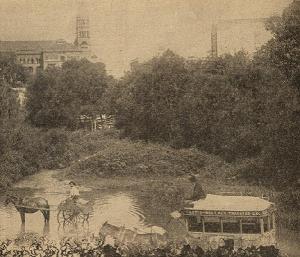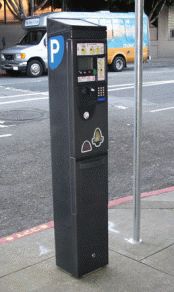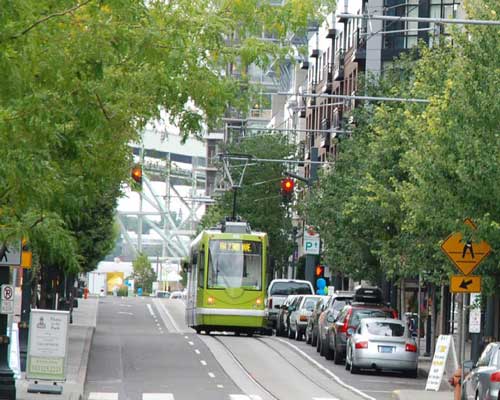Commuting Construction and closures History Roads Transit Uncategorized
by Hugh
1 comment
The only thing to look forward to is the past

Omnibus soaking its wheels in the SA river
With all the zippidy-doo-dah hoopla over the possibility of a return to streetcars, why not go the whole hog and bring back mule drawn omnibuses? I mean, who else is doing that? Let’s think outside the box and get out of Portland, Oregon’s shadow once and for all. Think of the benefits. No expensive overhead or the need to tear up streets for miles on end and tourists will love it.
Mule drawn streetcars were introduced in San Antonio in 1878 but omnibus service has that beat by seven years. It cost 5 cents to go from Main Square to Alamo Plaza. With all the money we’ll save by not installing staggeringly expensive streetcar systems and their unsightly overhead power lines, we could go back and charge the same fare in 2010 that it was in 1871. I guess there is a flaw in my logic somewhere but, you know, I’ll be d****d if I know what it is.
Commuting Passenger rail Roads Toll roads Transit: Broadway South Alamo Street streetcars U.S. 281
by Patrick
Comments Off on Streetcar dreams: Now it’s time to talk money
Streetcar dreams: Now it’s time to talk money
After starting the fiscal year by shaving $19 million in spending, including 330 jobs, the city is now being asked to kick in $17 million to build a two-mile streetcar line.
That’s just part of the bill to buy streetcars and lay rails along Broadway and South Alamo Street by 2014. The county, VIA Metropolitan Transit and the federal government could also pony up to help pay what would be an estimated $90 million.
City Council heard the pitch this afternoon.
“If there was any sticker shock … council members mostly kept it to themselves,” the Express-News wrote.
The city hasn’t made any commitments, at least not yet.
At $45 million a mile, the price tag is quite a bit cheaper than, say, turning U.S. 281 out by Stone Oak into a superhighway, or, I should say, tollway.
Ah, but already I’m talking apples and oranges. This quaint two-mile rail line wouldn’t be a wide commuter route helping connect San Antonio’s core to its fringes.
Nope, unlike U.S. 281’s role as an artery for sprawl, the rail line, if done well, would be a magnet for compact living, working and playing. The idea is to drive some growth to the inner city, by creating a place where people would gladly leave their cars behind more often. Tourists would love it too.
Nonetheless, critics and proponents will duke it out with such comparisons. And with so many angles on varying public and private costs, some visible and some not so visible, expect a debate that’s about as clear as mud.
Docs and links:
Pay-and-display could be coming downtown

Pay-and-display station in San Francisco
The San Antonio City Council this Thursday will consider whether to approve a plan to replace most downtown parking meters with so-called “pay-and-display” systems. (UPDATE: Council approved the plan during its 3/4/10 meeting.) These systems, which originated in Europe and have become popular in US cities over the past decade, consist of a payment machine (“pay station”) located on each block, such as the one pictured to the right. After parking your vehicle, you locate the nearest pay station, pay for the time you want to park, get a receipt from the machine, then return to your vehicle and place the receipt on your dashboard. The drawback to this system, of course, is that you have to walk to the machine (which typically is located mid-block), pay, then return to your vehicle to put the receipt on the dashboard. The benefits, however, are that the machines accept credit/debit cards and dollar bills, so no more having to scrounge for loose change. Also, motorists can move their vehicle if desired without having to “feed” another meter. The City is the biggest benefactor in the form of reduced maintenance costs and collection overhead for thousands of parking meters; remote maintenance of the machines via wireless connections; and enhanced revenue, likely the result of more people opting to pay since they can use credit cards and bills. Also, unlike with parking meters where any remaining time is inherently donated to the next person who parks in the space, leftover time under pay-and-display systems is essentially forfeited to the City. Studies generally show that parking violations are reduced under pay-and-display systems, so the City would lose some revenue from parking tickets, but can, as a result, reallocate those enforcement resources to other areas.
Gas taxes Toll roads: election Governor
by Brian
Comments Off on Governors’ transpo planks
Governors’ transpo planks
Well over a month ago now, I critiqued Kay Bailey Hutchison’s transportation policy plank of her gubernatorial platform. I had intended to review the other candidate’s proposals soon thereafter, but alas, got sidetracked. With the primary elections tomorrow, I thought it might be time to finally get to it. 🙂
The candidates’ (major candidates only) policy statements are evaluated in order of their current polling numbers, Republicans first.
